The 10 Best Dive Computers Every Underwater Junkie Should Own
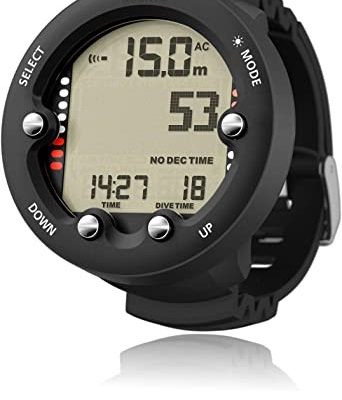
Suunto Zoop Novo
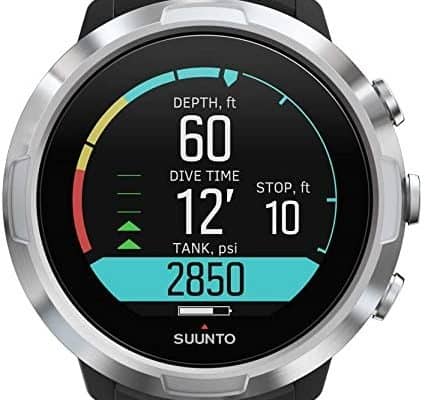
Suunto D5
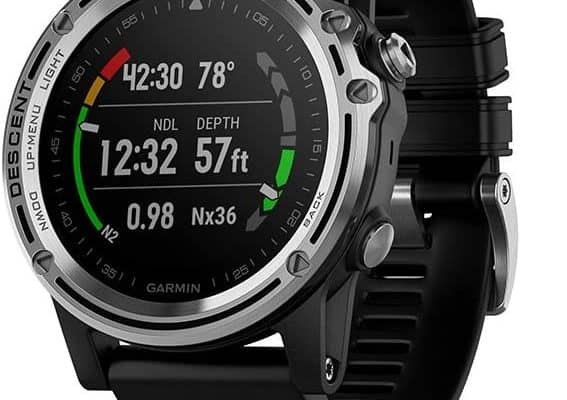
Garmin Descent Mk1
Exploring the underwater world is exhilarating, and those who have tried it once typically go back for more. It, therefore, comes as no surprise, then, that scuba dive is soaring in popularity each year. While it’s a thrilling experience, it’s in an unknown area.
So, it’s essential to take safety precautions, such as investing in the best dive computer, as you embark on your underwater adventures.
Doing so will allow you to monitor important information as you explore the deep blue sea. After all, when you’re underwater, you can easily get disoriented, lose direction, and not know your current depth, particularly for beginners.
With this handy gadget, you can avoid decompression sickness as it will effectively log your dive. In today’s digital era, the best dive computer comes in the form of a sleek, lightweight watch strapped to your wrist, ideal for everyday use.
But, with the wealth of options that have littered the market, selecting the ideal option can be an uphill battle. To the unfamiliar eye, they all look the same.
Luckily, you’ve come to the right place as we’ve rounded up the top 10 picks that will take your dive experience to the next level.
Mares Puck Pro
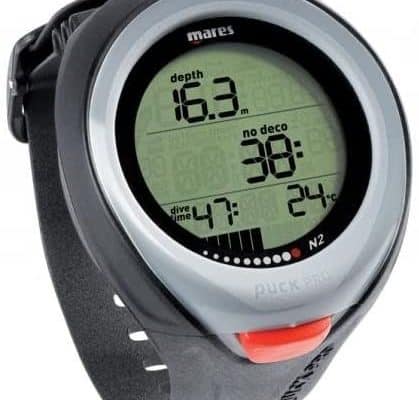
Some divers say that this dive computer was named for its ‘hockey puck’ design. And, there’s some truth to this as the Mares Puck Pro isn’t winning points on style. But, if you’re on the quest for a durable product that’ll get the job done, then this wrist dive computer takes the cake.
It comes with three simple operating modes (Bottom Time, Nitrox, and Air), an oversized display, and user-friendly menus that make it a great option for beginners.
With the Mares Puck Pro, you can adjust your dive limits by selecting a more conservative profile for an added layer of safety. Its rugged and sturdy plastic and rubber exterior can withstand the abuse of daily deep-sea diving and anything Mother Nature throws at it. And it will make an amazing backup computer someday when you hone your dive skills.
Pros
- Changeable battery
- Compatible with PCs
- LCD screen
- Runtime of up to 36 hours
- Depth rating of up to 492 feet
- Designed from sturdy and durable materials
- Oversized, easy-to-read display
- Usable as a stopwatch
Cons
- No user manual
- Pricey
Suunto Zoop Novo

It’s no secret that Suunto Zoop has been the go-to option for newbies for decades. And the new Novo dive computer is no exception. It’s one of the most basic options in the market, with four user-friendly operating modes and an oversized, easy-to-read display.
The Suunto Zoop Novo also has intuitive menus that make it suitable for beginners and divers that wear prescription lenses. And, with a highly conservative preset dive profile, seasoned divers can feel slightly limited under the deep blue sea.
But remember, this added safety feature is targeted for newly certified students and divers. So, if you’re hard on your gear, then keep this in mind. The Suunto Zoop Novo has a sturdy dry suit compatible wrist strap, user-changeable battery, and tough exterior.
Pros
- Memory of 50 hours
- User-replaceable battery
- Depth rating of 328 feet
- Affordable
- Sturdy exterior that can withstand extreme wear and tear
- Compatible with cold water
- Phosphor-Luminescent Display
- 4 easy operating modes
Cons
- More suitable for beginners than experienced divers
Cressi Leonardo
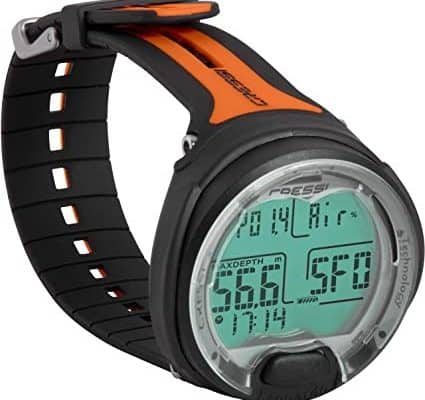
Are you on the quest for the best dive computer that gets the job done with the utmost efficiency? Then the Cressi Leonardo is your best bet. It’s a pocket-friendly option that uses one button for its settings and menus, making it a breeze to navigate and adjust to your preference.
With a low-profile design, the Cressi Leonardo is a snug fit as a watch than a dive computer. So, it’s more aesthetically-pleasing compared to other dive watches such as the Mares Puck Pro, and you can easily reset it in between dives.
In turn, this makes it the go-to option for divers that share gear and shop rentals. But remember, the Cressi Leonardo’s
Pros
- Available in different colors
- Sophisticated design
- Can be used by multiple divers per day
- Budget-friendly
- Memory of up to 70 hours
- Adjustable dive profile for a more conservative experience
- Compatible with Windows and Mac PCs
Cons
- Can only be used in warm water
Suunto D4i Novo
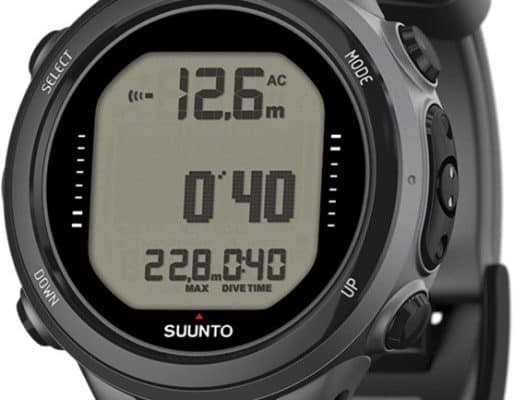
Dollar for dollar, the Suunto D4i Novo is one of the best dive computers that money can buy. It has more operating than competing modes, easy customization of alarms and diver profiles, and gas blending. These user-friendly features are rolled into a compact wristwatch. But keep in mind that this dive computer is not an ideal fit for beginners.
The D4i’s complex menus and four-button design make it a better option for advanced and intermediate divers. If style matters to you, then you’re in luck because the D4i comes in a vast assortment of colored straps to choose from that can brighten anyone’s day.
And it doubles as a wristwatch for daily wear, thus making popular options for dive professionals.
Pros
- Doubles as a wristwatch
- Effectively monitors oxygen tank pressure
- Comes in various colors
- Up to 80 hours of memory
- Perfect for dive professionals
- Customizable alarms and diver profiles
Cons
- Not suitable for newbies
Sherwood Vision
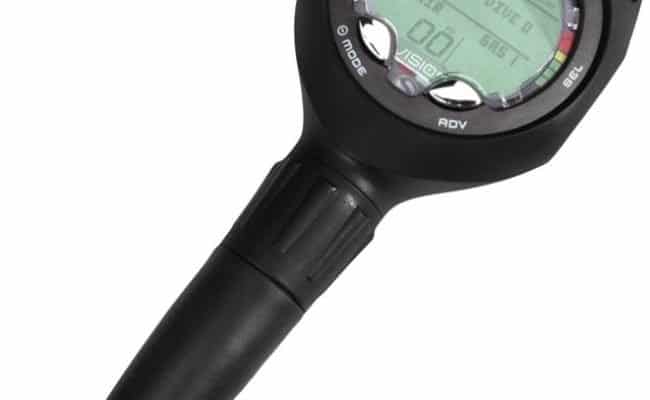
Let’s face it. In today’s digital era, there is a soaring number of divers that are gravitating more towards watch and wrist style dive computers. However, consoles are a great alternative for beginners. And the best part is that they don’t need to be bulky.
Sherwood Vision is littered with all the features of conventional gauges and dive computers. And they’re rolled into a compact housing.
The handy gadget supports a gas blend of up to 100% oxygen and effectively monitors depth and air consumption. So, it’s an amazing option for seasoned divers and those that prefer dive with a 2nd computer for redundancy.
Furthermore, Sherwood Vision utilizes a quick disconnect hose that makes it a breeze to remove and neatly store.
Pros
- Supports multiple gas blends in one dive
- 3 operating modes available
- Quick disconnect hose for travel, cleaning, and storage
- Compatible with cold water
- User-changeable battery
- LCD backlighting
- Perfect for advanced divers
Cons
- Only 24-hour memory
- More compact making it harder to read
Mares Quad
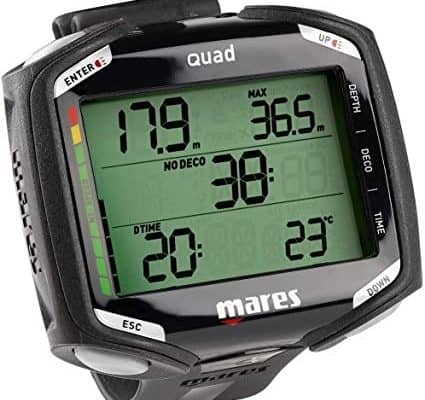
The first thing that will capture your attention on the Mares Quad dive computer is its size. Granted, it doesn’t score fashion points. But its oversized screen is a perk that sets it apart from the pack. The Mares Quad is a great alternative for divers that grapple with reading small displays or wear prescription eyewear.
Furthermore, it’s jam-packed with features that advanced and intermediate divers will love. For instance, you can alternate gasses during a dive. Secondly, it supports an oxygen blend of up to 99%. Thirdly, you can fully rest in between dives, thus making the Mares Quad the go-to for divers that share gear or rental equipment.
Pros
- Usable in cold water
- High depth rating of 492 feet
- Doubles a stopwatch
- Uses multiple gas blends in one dive
- Oversized, easy-to-read display
- Suitable for divers that struggle to read small displays
Cons
- Bulky design
- Not ideal for newbies
Aqua Lung i450T

Are you an avid traveler or diver? Then, it’s a no-brainer that you’ll gravitate more towards a compact and lightweight dive computer. Fortunately, the Aqua Lung i450T packs all your needed features into a tiny package. Moreover, it’s tough enough to withstand wear and tear from several daily dives and air travel.
Not only does the Aqua Lung i450T allow you to alternate between 3 gasses per dive but also facilitates wireless integration via Bluetooth transmission. So, this makes it an excellent alternative for various technical applications.
Furthermore, the i450T has a user-replaceable battery, which saves you the hassle of looking for a service center amidst your dive adventures. Apnea and snorkeling enthusiasts will be pleased to learn that this model has an additional free-dive mode.
Pros
- User-changeable battery included
- Perfect for technical applications
- Uses several gas blends per dive
- 4 buttons for enhanced customization
- Wireless Air Integration via Bluetooth
- Also functions as a wristwatch
Cons
- Memory of up to 24 hours
- Pricey
Suunto D5

Does your profession revolve around water? Are you on the quest for the best dive computer that’s to the challenge for daily use? Then the Suunto D5 is right up your alley. It’s a new model in the market that packs all the features of the Suunto predecessors but throws in a few pleasant surprises.
For starters, a rechargeable battery that makes this dive computer suitable to use in remote areas. Secondly, it has alarms that are set to vibrate as opposed to chiming, for more peaceful underwater experiences.
Thirdly, the Suunto D5 has optional air integration, multilingual (supports up 18 languages), and wireless syncs to iOS and Android devices. Lastly, it doubles as a wristwatch and contains a changeable band for divers with a great fashion sense.
Pros
- MIP full-color display
- Changeable band
- Chiming and vibrating alarms
- USB charging
- Monitors tank pressure via Wireless Air Integration
- Uses various gas blends in one dive
- Compatible with mobile devices and PCs
- Memory of up to 200 hours
- Digital compass included
Cons
- Expensive
Scuba Pro Galileo 2
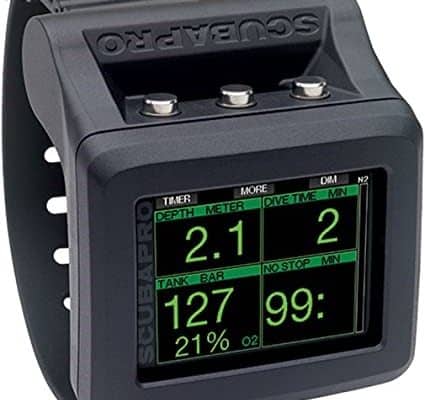
As the latest model in the Galileo line, the G2 is the best dive computer from Scuba Pro. Granted, it doesn’t win any fashion points. But, its functionality surpasses its appearance. The G2 is not only easy to use and read but is also stacked with features geared towards excellent technical and recreational dive.
It facilitates wireless integration for up to 9 tanks with color codes (green, red, and yellow) that mark the air levels. Secondly, you’ll find different modes for Trimix, re-breather, side-mount, and free-dive.
Thirdly, even with all this going on, the G2’s three-button design and full-color screen make it a walk in the park to use underwater. And its custom menus give you free rein to view as little or as much detail as you please during your dive adventures.
Pros
- Full TFT color display
- Impressive memory of up to 1000 hours
- 7 operating modes to choose from
- User-changeable battery
- Monitors breathing rate, heart rate, and skin temperature
- Easy-to-read, oversize display
- Wireless Air Integration for 9 tanks
- Perfect oxygen blend of 8 gasses
Cons
- Significantly pricier than most dive computers
- Bulky for divers that prefer compact models
Garmin Descent Mk1

If you’re looking for a dive computer that’s not only aesthetically-pleasing but also has more features than its rivals, then the Garmin Descent Mk1 is your Holy Grail. Stylish enough to wear every day, this handy device has different modes for multiple outdoor activities ranging from swimming and hiking to biking.
And it uses GPS to track your location above and underwater, supports a maximum of 6 gas blends, including Trimix, and monitors your heart rate. With a charging station and rechargeable battery included, finding a service center during your dive holiday is the least of your worries.
The MK1’s full-color screen displays a photo backdrop and is impressively easy-to-read. Moreover, it can sync to your smartphone, PC, or tablet, thus making logging dives a walk in the park.
Pros
- MIP full-color display
- GPS tracking
- Monitors the heart rate
- Doubles as a wristwatch
- Multisport functions
- Up to 1000 hours of memory
- Oxygen blend of 6 gasses
- Depth rating of up to 328 feet
- Easy to read
Cons
- Expensive
- Screen is susceptible to cracks and scratches
Buying Guide: How to Choose the Best Dive Computer
Armed with the knowledge on the top 10 dive computers that will give you value for your money, let’s explore the key buying factors to consider.
Oxygen Blend
There is a soaring number of divers that are opting for greater oxygen blends to boost their underwater performance and resist fatigue after their dive sessions. So, if taking on these new challenges piques your interest, then it’s a no-brainer. You need a dive computer that’s a beast in juggling several gas blends. For a myriad of recreational divers, two gasses with up to 50% oxygen is abundant. However, advanced divers will want a model that can handle a blend of up to 8 gasses along with Trimix and 100% oxygen.
Display Type
A plethora of entry-level dive computers use an ELD or black and white LCD backlit screen. These displays use easy-to-read, bold digits for better visibility in direct sunlight and low light. Backlit screens typically utilize phosphor-luminescent technology to illuminate and maintain a glow after shining a dive torch on them.
So, even if the device’s backlight malfunctions, you can still read the screen display. Full-color screens are increasingly popular courtesy of their in-depth displays and visual allure. But remember, these types of screens are challenging to read in direct sunlight and bright light. And they’re more fragile. So, if you’re a beginner, a basic dive computer will get the job done.
Number of Buttons
If you’re a newly certified diver, it’s advisable to opt for a dive computer with as few buttons as possible. Granted, superior models come with up to 5 buttons; newbies may find them hard to juggle and can be confusing underwater.
But basic designs are easier to navigate and won’t leave you disheartened mid-dive. For professional divers with more experience using advanced models, this buying factor is less important.
Operating Modes
A multitude of entry-level dive computers come with fundamental modes such as the Nitrox and Air. You’ll also find a gauge that monitors your bottom time and depth without factoring in your no-decompression limits. Advanced models include options such as a watch that allows your dive computer to double as a wristwatch and free-dive.
High-end designs that are well over $500 include advanced functions such as Trimix and re-breathing. So, if you’re up for different dive challenges to hone your skills, then you’ll require at least two computers to add a layer of safety and redundancy. Remember, a basic model is a great starting point before advancing to the pricier advanced models down the road.
Battery Type
If your dive plans revolve around remote and exotic destinations, then a dive computer that demands professional servicing when the battery runs low is a recipe for frustration. Select a product that has a rechargeable battery or one that’s user-changeable to avoid resigning yourself to this fate.
Compatible Technology
Look for dive computers that perfectly sync with smartphones and tablets (iOS and Android-powered) and PCs to log and plan your dives. While some entry-level models use USB linking, the more advanced dive computers use Bluetooth.
Wireless Air Integration
The best dive computer uses Wireless Air Integration that’s synced to a Bluetooth transmitter mounted to the first stage of your regulator. It’s this external sensor that relays pressure to the mounted display, where’s readable.
Wireless transmitters usually don’t come with dive computers, which means you’d have to shell out extra bucks. Furthermore, they’re fragile gear that’s susceptible to damage. Nonetheless, seasoned divers concur that they’re well worth the extra cost.
Adjustable Dive Profile
A dive computer computes your no-decompression limits by using formulas known as algorithms. It gives you free rein to personalize your dive profile in a conservative and mathematical model depending on your experience level and comfort. Even the most liberal dive profiles guarantee your safety and well within your capabilities. And it can aid in scoring additional minutes underwater.
Optional Added Deep Stop
If you’re a beginner, then deep stops are the least of your worries. However, if you’re aiming to explore deeper, then your dive computer may recommend extra stops amidst your ascent.
With the addition of stops to your driving profile’s suggested ‘safety stop’ at 5 meters for 3 minutes, your body gets adequate time to expel the nitrogen in your tissue. Doing so curbs the likelihood of decompression sickness and injury.
And, it ushers in a safer trip back to the water surface. The best dive computer allows you to remove or add these stops that trigger a more or less conservative dive profile.
Residual Nitrogen Reset
In some dive computers, you can entirely reset the memory between dives. As a result, they can be shared by different divers per day without the need to account for previous dive profiles. So, this is an essential factor to consider if you’re buying a dive computer as rental equipment for clients or students.
Several Gasses In One Drive
If your goal is to make decompression stops during your dive sessions, then it’s essential to use at least two gas blends while underwater. By incorporating a 2nd gas whose percentage surpasses that of oxygen, your body can release unwanted nitrogen in a jiffy. It’s this quicker ‘off-gassing’ that lowers the amount of time required for safe ascents.
Cold Water Compatibility
A dive computer that’s built with cold water in mind incorporates unique and user-friendly features. So, if you want to take the plunge into icy conditions, ensure you choose a product with oversized buttons that are easy to press with thick gloves on. Moreover, you’ll require a long wrist strap that’s a snug fit over a dry or wet suit.
To Wrap It Up
Delving into the underwater world is something everyone should experience at least once in their lifetime. And some become hooked to the majestic underwater life after their first experience.
But, for much-needed peace of mind, it’s essential to take as many precautions as you can while you delight in the thrill.
Fortunately, with the best dive computer, you’re assured of an exhilarating and safe underwater experience. So, order yours today!
Categories: Reviews
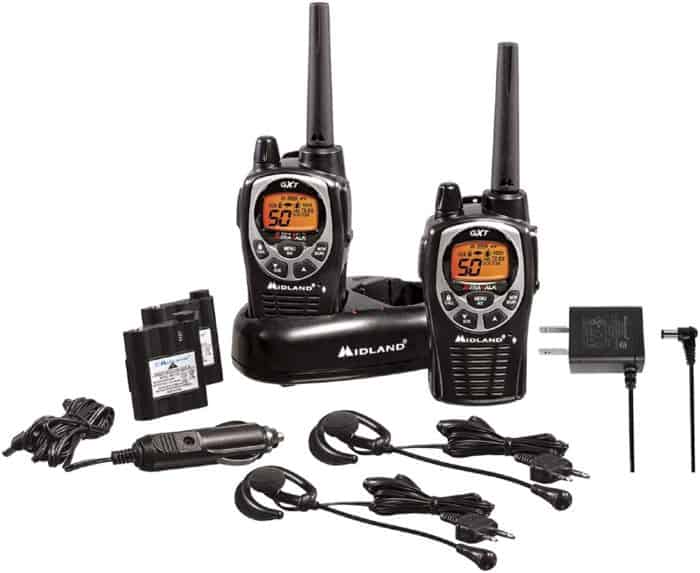


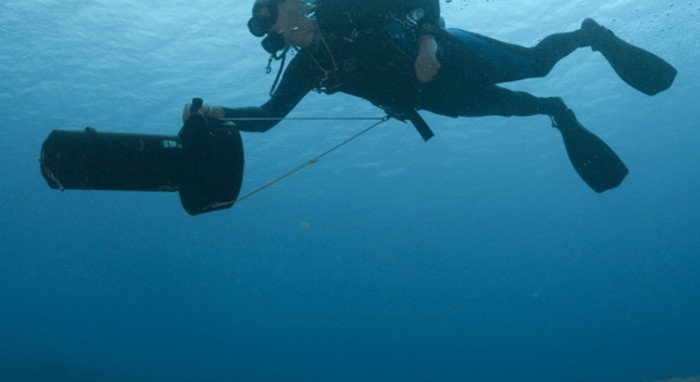








1 Comment
Scott Beckstead on June 8, 2021
Why did the Shearwater Teric not make the list?